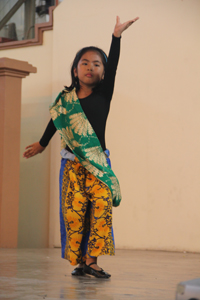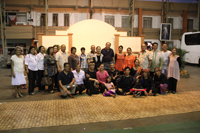The year 2011 was a milestone for the AlunAlun Dance Circle.
Ligaya Fernando-Amilbangsa returned to Tawitawi on 25 September 2011 to receive the award as the “Most Outstanding Artist of Tawitawi” given by the Tawitawi Provincial Grovernment on 27 September 2011.
The occasion allowed Ligaya Amilbangsa to re-connect and share with the artists and the people belonging to various ethnic groups—the Samal, Badjaw, Jama Mapun and the Tausug– who gave her their confidence and trust in documenting their lifeways and various artistic expressions four decades ago. Through this journey, Ligaya Amilbangsa came full circle as an artist and as a cultural conservationist.
Flashback
October 08, 2011
By Ligaya Fernando-Amilbangsa
Barely a day after my arrival from a seminar in Bangkok, I was again on my way to the airport at the ungodly hour of 1:30 a.m. on Sunday, September 25, 2011.
Nannette, Neil (the cinematographer), and myself patiently waited and speculated as to the whereabouts of Maricor. She was nowhere in sight until the break of dawn when we boarded the flight to Zamboanga City.
Alas! We were a happy foursome on the connecting flight to Bongao, Tawitawi that same morning to catch up with the 10th Agalagal Festival.
After the usual arrival preliminaries at the Sangasanga airport, our group immediately proceeded to Bongao where the street parade was already in progress. It was hard to believe that I was in the midst of such a display of pomp and color in the capital of Tawitawi; the ati-atihan percussive rhythm assailed my ears, instead of the familiar instrumental and vocal music I heard all over the place four decades ago.
Such was the contrast that seemingly transported me to an entirely different world in the past: the call to prayer at daybreak from a distant mosque; the tantalizing cadence of kulintangan music that wafted unexpectedly anytime from somewhere; the engaging lilt of lelleng sung passionately after sundown by a neighborhood boy with a captivating voice; the hypnotic sound of lugo earnestly intoned from afar; the lullaby hummed by a solicitous mother to pacify a baby in a makeshift cradle on a boat. The memory is too numerous to enumerate.
The garish colors, fabrics, and decorations of the costumes and props in the parade jolted me. What has the festival done to the community? And what has the community done to itself? I cringe at the destructive effects of such an expensive and frivolous activity to the cultural well-being of Tawitawi – identified as one of the poorest provinces in the country, but certainly very rich culturally and historically. What a pity that all these go to waste due to misdirection at all levels.
Are the schools asleep? Are the people sleeping? Are the government institutions snoring in a deep slumber? Is everyone oblivious, or simply ignorant of what is true, beautiful, real, and functional in their particular environment? The natives owe it to themselves to wake up fast enough to preserve and conserve and harness their cultural uniqueness to reap the economic benefits of tourism, but above all to assert their ethnic identity.






